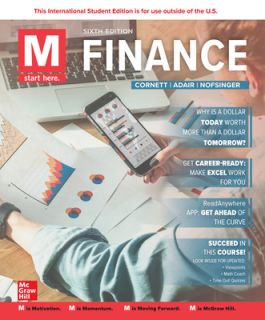M: Finance ISE
After purchasing your eBook, login to the McGraw Hill Bookshelf website and redeem the access code from your order confirmation email.
- Access your eBook online or offline
- Easily highlight and take notes
- Fully searchable content
- Syncs across platforms
NOTE: eBook purchase does not include Connect homework or adaptive SmartBook assignments
PART ONE:INTRODUCTION
Chapter 1:Introduction to Financial Management
PART TWO:FINANCIAL STATEMENTS
Chapter 2:Reviewing Financial Statements
Chapter 3:Analyzing Financial Statements
PART THREE:VALUING OF FUTURE CASH FLOWS
Chapter 4:Time Value of Money 1: Analyzing Single Cash Flows
Chapter 5:Time Value of Money 2: Analyzing Annuity Cash Flows
PART FOUR:VALUING OF BONDS AND STOCKS
Chapter 6:Understanding Financial Markets and Institutions
Chapter 7:Valuing Bonds
Chapter 8:Valuing Stocks
PART FIVE:RISK AND RETURN
Chapter 9:Characterizing Risk and Return
Chapter 10:Estimating Risk and Return
PART SIX:CAPITAL BUDGETING
Chapter 11:Calculating the Cost of Capital
Chapter 12:Estimating Cash Flows on Capital Budgeting Projects
Appendix12A: MACRS Depreciation Tables
Chapter 13: Weighing Net Present Value and Other Capital Budgeting Criteria
PART SEVEN:WORKING CAPITAL MANAGEMENT AND FINANCIAL PLANNING
Chapter 14:Working Capital Management and Policies
Appendix 14A: The Cash Budget
M:Finance was developedfor the undergraduate corporate finance course and designed with today'sstudent in mind. With years of teaching experience as well market development,the author team developed a text to reflect that this critical course covers somany crucial topics and that instructors need to focus on core ideas to ensurethat students are getting the preparation they need for future classes—and fortheir lives beyond college.
The framework for M: Financeemphasizes three themes: (1) Finance is about connecting core concepts, (2)Finance can be taught using a personal perspective, and (3) Finance focuses onsolving problems and decision making.

